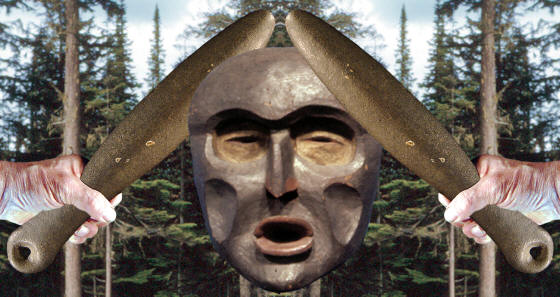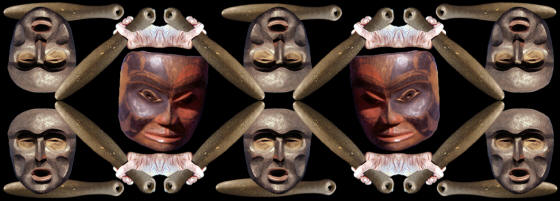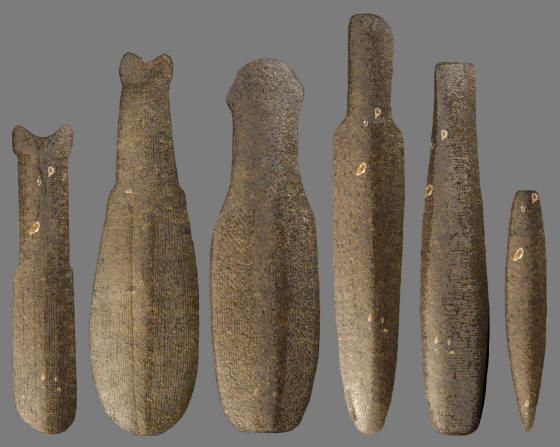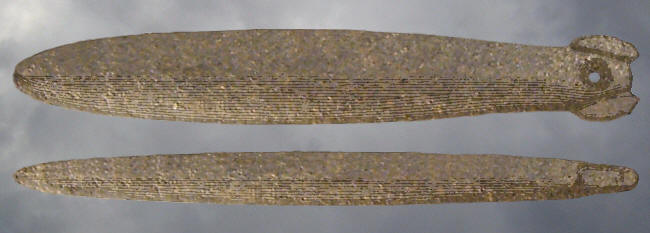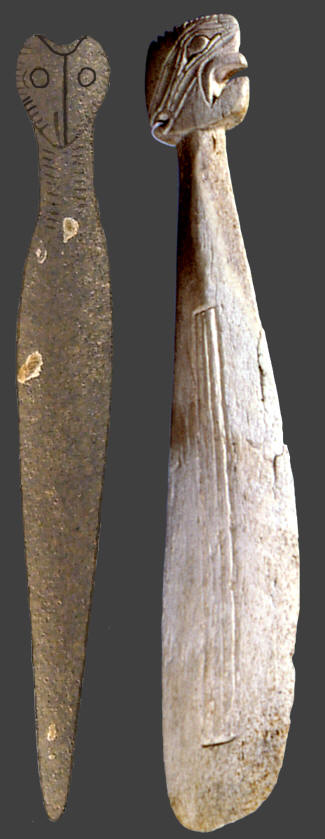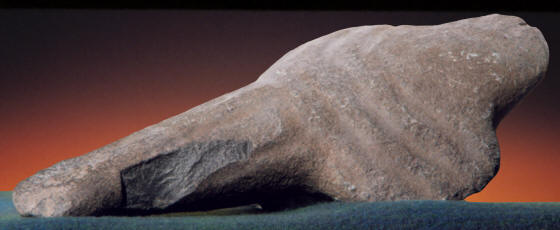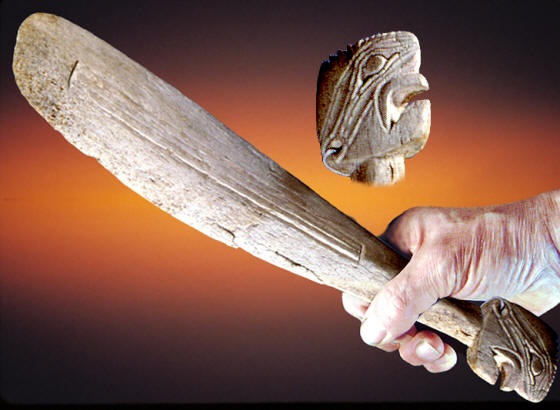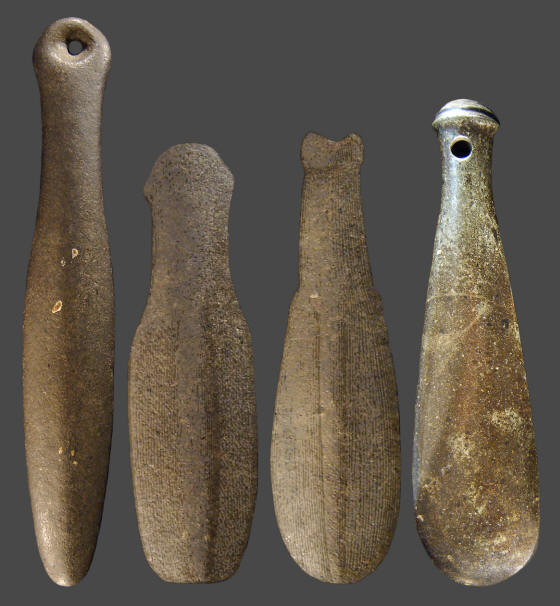|
||
|
||
|
"These people (Nootka
people, British Columbia) have bows,
and arrows, spears, slings, short truncheons (clubs)
made of bone and a small pick-axe---. From the number of their weapons
it may be reasonably concluded, that they engage frequently in close
combat; and we had very disagreeable proofs of their wars being both
frequent and bloody, from the quantity of human skulls that were offered
to us for sale."--------1784-1786, Captain
Cook, from account of Captain Cook's third voyage within bound text
published in 80 parts, George William Anderson, "---Complete Collection
Of Voyages Round The World---Captain Cook's First, Second, Third And
Last Voyages,---" p. 541.
Northwest coast clubs were made in such a wide variety of sizes and designs that many of them seem to have been made as one-of-a-kind styled clubs. But there are many that do seem to follow a certain typology. Stone clubs are unique for the fact that they are complete fighting weapons, just as they were made, without any additional hafting elements. They were produced in the northwest coast of North America and no where else on the continent. The oldest stone clubs were produced at least 2,000 years ago in Oregon, Washington and British Columbia. Stone clubs served as utilitarian tools for dispatching animals and for fighting. They also served as nonutilitarian tools for display and ritual. Some of the more skillfully crafted examples have impressed scholars and collectors for their artistic design since the late 1800's. Very few stone clubs have been reported from scientific excavations. Most are reported as random finds. |
||
|
Estimated dates for northwest coast stone clubs range from 500 B.C. to European contact. One documented club, that was excavated in Prince Rupert harbour on the Kitandach site in central British Columbia, dates to sometime between A.D. 1 and A.D. 500. It's described as a simple form with a ribbed blade and a phallic designed handle end. The earliest evidence for the use of stone clubs is found on the bones of Period II (Middle Pacific) burials. They show a high incidence, in male burials, of forearm fractures called parry fractures and skull depression fractures. The skull fractures match the knoblike handle ends on stone clubs. |
||
|
The most significant and largest discovery of northwest coast stone clubs was found in 1898 by Chief Johnny Muldoe. He found a cache of 35 clubs while digging a hole for a house-post in the First Nation Village of Hagwilget in central British Columbia. They are reported to have been found approximately four to five feet below the surface. Most of them are carved with either bird or mammal head forms and thirteen have phallic designed handle ends. One example is carved with a human head on the end of the handle. The most peculiar aspect about the Hagwilget cache clubs is that they are described more as emblems of clubs rather than true fighting weapons. Some of them are either to small, delicate, or made from soft sandstone to serve as effective weapons. Duff (1975) writes that, "One of the most curious things about the stone clubs is they are not so much functional weapons as they are images of weapons." |
||
|
||
|
There is a wide range of style and quality of manufacture for northwest coast stone clubs. They vary from simple undecorated forms to complicated stylized forms with carved animal ornamentation. Lesser artistic examples were used for dispatching animals or fighting. The more delicate and rare complex forms were used for display & ritual. Stone pestles as long as 24 inches were also made in the northwest coastal area and they may represent the seeds of development for stone clubs. |
||
|
||
|
Abnormally small clubs and especially elaborate stone clubs have been reported that would have no practical use as weapons. They probably functioned as either items of display or possibly as shamanic tools used to battle evil forces. Shaman's tool kits often contained ceremonial weapons for fighting. Small bone pendants in the shape of clubs are reported that measure 2 or 3 inches (5 or 8 cm) long. Some of the clubs in the Hagwilget cache were made of soft stone and have delicately carved projections that would easily break if used for striking. |
||
|
Northwest coast clubs were made of stone, bone and wood. The largest number were probably made from wood. Basalt and serpentine are two of the hard stones that were used to make stone clubs. They were also made from soft stone, such as sandstone. Bone clubs are identified as whale bone. Some examples were made from the jaws of killer whales. Clubs made of wood were made from hardwoods such as maple. |
||
|
||
|
Writers often comment about the similarity of the stone clubs used by the Maori of New Zealand to those found in the northwest coastal area of the U.S. and Canada. Although most of the northwest coast clubs are not similar in design to Maori clubs, enough examples have been found with perforated handles and wide blades to offer an argument of similarity. What is most interesting is that both cultural areas were using stone clubs at the same time from the 17th century into the 19th centuries. The Maori began using them very late compared to those used in the northwest coast. Fighting clubs, made only of stone, are so rare in the world it's hard to believe the two locations were not in contact with each other. But separate invention of similar tool types and technology is not unknown. The northwest coast stone clubs are more bulkier than the Maori clubs which are ground and polished to thin and sharp edged blades. |
||
|
||
|
Clubs have been described as ambiguous things that have two meanings. They can be tools for life-taking or they can be seen as tools for life-preserving. The living hand on the handle activates the process of life and death. Current evidence seems to show that northwest coast stone clubs were used in close combat fighting in attacks where no quarter was given. |
||
|
"REFERENCES"
1784-1786, Cook, James, from account
of Captain Cook's third voyage within bound text published in 80 parts,
George William Anderson, "---Complete Collection Of Voyages Round The
World---Captain Cook's First, Second, Third And Last Voyages,---". |
||
